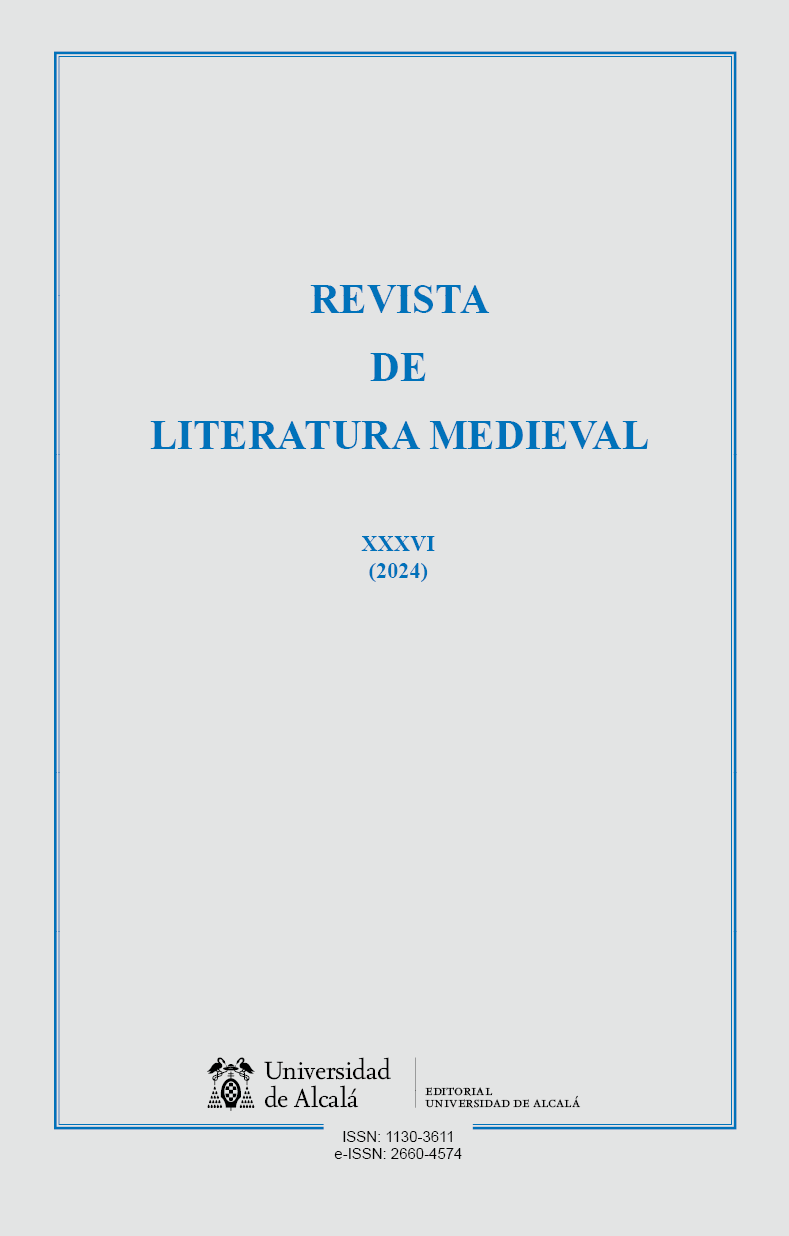Prior of San Juan, Castilian jouster of the Cancioneiro Geral, by Garcia de Resende (1516)
DOI:
https://doi.org/10.37536/RLM.2024.36.1.101250Keywords:
Songbook Poetry, Cancioneiro Geral, Garcia de Resende, Inventions, Juan de Valenzuela, Prior de San Juan, Poetry and ideologyAbstract
According to Garcia de Resende, the Prior of San Juan is one of the participants in the poetic jousts that took place during the wedding celebrations between the Portuguese crown prince, the infant Afonso, son of the kings of Portugal, D. João II and D. Leonor, and the princess Isabel, the heir of the future Catholic Kings. The relative position of this participant in the aforementioned game suggests an importance which understanding is complex for historical, political, diplomatic and poetic reasons. Through the analysis of the poetic creation assigned to the Prior of San Juan, of the paratextual data that frame it and of secondary historical sources on this figure who dialogues, at the same time, with the religious, military and political dimensions of peninsular history at the end of the 15th century, this article is dedicated to deepen the knowledge and to discuss the meaning of the inscription of the Prior of San Juan and his invention in the Cancioneiro Geral de Garcia de Resende (1516).
Downloads
Métricas alternativas
References
Barquero Goñi, Carlos (s. f.), Juan de Valenzuela. Real Academia de la Historia. En línea: <https://dbe.rah.es/biografias/32135/juan-de-valenzuela> [consulta: 03/08/2023].
Barquero Goñi, Carlos (1998), «Disputas por el priorato del Hospital en Castilla durante los siglos XIV y XV», Hispania, 58/199, pp. 537-557. DOI: https://doi.org/10.3989/hispania.1998.v58.i199.647.
Barquero Goñi, Carlos (2006), Los Hospitalarios en La España de los Reyes Católicos (1474-1516). Gijón: Ediciones Trea.
Botta, Patricia (2008), «La rubricación cancioneril de las letras de justadores», en A. Garriba (ed.), Rúbricas Ibéricas. Roma: Aracne, pp. 135-155.
Costa, António Carlos Martins (2016), «As Ordens Militares em combate nos finais da Idade Média: o caso da Guerra da Sucessão de Castela (1475-1479)», Medievalista, 19, s. p. DOI: https://doi.org/10.4000/medievalista.1007.
Dias, Aida Fernanda (ed.) (1990-1993), Cancioneiro Geral de Garcia de Resende, 4 vols. Lisboa: Imprensa Nacional/Casa da Moeda.
Dias, Aida Fernanda (2003), Cancioneiro Geral de Garcia de Resende, vol. VI: Dicionário (Comum, Onomástico e Toponímico). Lisboa: Imprensa Nacional/Casa da Moeda.
Dutton, Brian (1991), El Cancionero del Siglo XV. T. VII: Índices. Salamanca: Universidad de Salamanca.
Fernández Duro, Cesáreo (1901), «La Batalla de Toro (1476). Datos y documentos para su monografía histórica». Boletín de la Real Academia de la Historia, t. 38, pp. 249-267. En línea: <https://www.cervantesvirtual.com/obra/la-batalla-de-toro-1476-datos-y-documentos-para-su-monografa-histrica-0/> [consulta: 03/08/2023].
Fonseca, Luís Adão da (2007), D. João II. Lisboa: Temas e Debates.
Gomes, Rita Costa (1993), «Rui de Pina», en Giulia Lanciani y Giuseppe Tavani (org.), Dicionário da Literatura Medieval Galega e Portuguesa. Lisboa: Caminho, pp. 597-598.
Hill, George Francis (1923), «Alexander the Great and the Persian Lion-Gryphon», The Journal of Hellenic Studies, 43/2, pp. 156-161. DOI: http://doi.org/10.2307/625805.
Ladero Quesada, Miguel Ángel (coord.) (2010), Edad Media. Historia Militar de España. Vol. II. Hugo O’Donnell (dir.). Madrid: Laberinto.
Macpherson, Ian (1998), The Invenciones y Letras of the Cancionero General. London: Queen Mary and Westfield College.
Neto, Dirceu Marchini (2017), «As Relações Sociais do Prior D. Vasco de Ataíde: o Priorado do Crato da Ordem do Hospital de 1453 a 1491», Mirabilia Jornal, 24/1, pp. 104-143. En línea: <https://www.revistamirabilia.com/issues/mirabilia-24-2017-1/article/social-relations-prior-vasco-de-ataide-priory-crato-order> [consulta: 03/08/2023].
Osório, Jorge Alves (2006), «Anotações sobre o Cancioneiro Geral de Resende», Máthesis, 15, pp. 169-195. DOI: https://doi.org/10.34632/mathesis.2006.4630.
Rocha, Andrée Crabbé (1993), «Garcia de Resende», en Giulia Lanciani y Giuseppe Tavani (org.), Dicionário da Literatura Medieval Galega e Portuguesa. Lisboa: Caminho, pp. 288-289.
Santa-Cruz, Noelia (2012), «El Grifo», Revista Digital de Iconografia Medieval, 4/8, pp. 45-65. En línea: <https://www.ucm.es/data/cont/docs/621-2013-11-21-GRIFO.%20Noelia%20Silva%20Santa-Cruz.pdf> [consulta: 03/08/2023].
Serra, José Corrêa da (ed.) (1792), Ruy de Pina, «Chronica d’ElRey D. Joaõ II», en Ineditos de Historia Portugueza. Lisboa: Academia Real das Sciencias de Lisboa, pp. 5-204.
Sousa, Sara Rodrigues de (2019a), «“Que venga toda fortuna”: Dom Diogo Pereira y Diogo de Mendonça, a partir de las justas reales de 1490», en Josep Luís Martos y Natalia A. Mangas (coords.), Pragmática y Metodologías para el Estudio de la Poesía Medieval. Alicante: Universidad de Alicante, pp. 359-370.
Sousa, Sara Rodrigues de (2019b), «Mutilación y (re)creación poética: las “letras” y “cimeiras” del Cancioneiro Geral, de Garcia de Resende», en Isabella Tomassetti (coord.) y Roberta Alviti et al. (eds.), Avatares y perspectivas del medievalismo ibérico, II. San Millán de la Cogolla: Cilengua, pp. 1227-1237.
Verdelho, Evelina (ed.) (2007), Garcia de Resende, Vida e Feitos d’El-Rey Dom João Segundo. Coimbra: CELGA/Faculdade de Letras de Universidade de Coimbra. En línea: <https://www.uc.pt/uid/celga/recursosonline/cecppc/textosempdf/01vidaefeitos> [consulta: 03/08/2023].
Published
How to Cite
Issue
Section
License
Copyright (c) 2024 Sara Rodrigues de Sousa

This work is licensed under a Creative Commons Attribution-NonCommercial-ShareAlike 4.0 International License.
The opinions and facts stated in each article are the exclusive responsability of the authors. The University of Alcalá is not responsible in any case for the credibility and aunthenticity of the studies.
Authors will retain the rights on their work, even if they will be granting the journal a non-exclusive right of use to reproduce, edit, distribute, publicly communicate and show their work. Therefore, authors are free to enter into additional, independent contracts for non-exclusive distribution of the works published in this journal (such as uploading them to an institutional repository or publishing them in a book), as long as the fact that the manuscripts were first published in this journal is acknowledged.
Works are published under the terms stipulated in the Attribution-NonCommercial-ShareAlike 4.0 International License (CC BY-NC-SA 4.0) that allows third parties to share the work under the following conditions:
Attribution — You must give appropriate credit, provide a link to the license, and indicate if changes were made. You may do so in any reasonable manner, but not in any way that suggests the licensor endorses you or your use.
NonCommercial — You may not use the material for commercial purposes.
ShareAlike — If you remix, transform, or build upon the material, you must distribute your contributions under the same license as the original.









